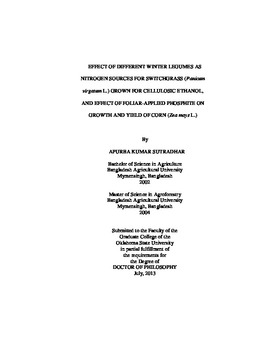| dc.contributor.advisor | Arnall, Daryl Brian | |
| dc.contributor.author | Sutradhar, Apurba Kumar | |
| dc.date.accessioned | 2014-09-24T14:17:09Z | |
| dc.date.available | 2014-09-24T14:17:09Z | |
| dc.date.issued | 2013-07 | |
| dc.identifier.uri | https://hdl.handle.net/11244/11048 | |
| dc.description.abstract | Scope and Method of Study: | |
| dc.description.abstract | Increasing fertilizer price has motivated scientists to find alternative sources of nitrogen to reduce cost of crop production. Because winter legumes may provide significant amount of nitrogen while conserving soil quality, the role of legumes intercropped with switchgrass (Panicum virgatum L.) warrants renewed attention. The objectives of this study were to investigate the effects of different winter legumes as a source of nitrogen on switchgrass dry matter yield, forage quality for biofuel production, and soil fertility status. A field experiment was carried out in which six winter legumes and four rates (0, 56, 112, and 168 kg ha-1 ) of fertilizer nitrogen were studied over a 3-year period. The second study was conducted to determine the effect of foliar-applied phosphite on growth and yield of corn (Zea mays L.). One major problem that affects the efficiency of foliar fertilization is the form of phosphorus. Phosphite is more reactive than widely used phosphate. A field study and a greenhouse study were conducted over a 2-year period in which the effect of foliar-applied phophite, soil-applied nitrogen and phosphorus were investigated on corn biomass yield, grain yield; grain, stem, and leaf P concentrations. | |
| dc.description.abstract | Findings and Conclusions: | |
| dc.description.abstract | Winter legumes did not increase switchgrass dry matter yield, cellulose, lignin, and hemicellulose content. The rate of 112 kg nitrogen ha-1 was required to achieve highest dry matter yield. Soil nitrate nitrogen, pH, and mineral content were largely unaffected. Soil organic matter depleted up to 33% after three years. As a replacement of fertilizer nitrogen, and to conserve soil productivity, winter legume-switchgrass intercropping system may not be recommended. In the field studies where phosphorus status was not significantly limited, foliar phosphite increased corn grain and biomass yield with soilapplied nitrogen fertilizer. No treatment effects were found in the greenhouse where initial soil phosphorus status was very low. In both studies, grain, stem, and leaf phosphorus concentration were largely unaffected by foliar phosphite. We concluded that, phosphite may be used as a partial supplement; however, may not be recommended when the soil phosphorus status is very low. | |
| dc.format | application/pdf | |
| dc.language | en_US | |
| dc.rights | Copyright is held by the author who has granted the Oklahoma State University Library the non-exclusive right to share this material in its institutional repository. Contact Digital Library Services at lib-dls@okstate.edu or 405-744-9161 for the permission policy on the use, reproduction or distribution of this material. | |
| dc.title | Effect of different winter legumes as nitrogen sources for switchgrass (Panicum virgatum L.) grown for cellulosic ethanol, and effect of foliar-applied phosphite on growth and yield of corn (Zea mays L.) | |
| dc.contributor.committeeMember | Raun, William R. | |
| dc.contributor.committeeMember | Mosali, Jagadeesh | |
| dc.contributor.committeeMember | Desta, Kefyalew | |
| dc.contributor.committeeMember | Dunn, Bruce. L. | |
| osu.filename | Sutradhar_okstate_0664D_12943.pdf | |
| osu.accesstype | Open Access | |
| dc.type.genre | Dissertation | |
| dc.type.material | Text | |
| thesis.degree.discipline | Soil Science | |
| thesis.degree.grantor | Oklahoma State University | |
